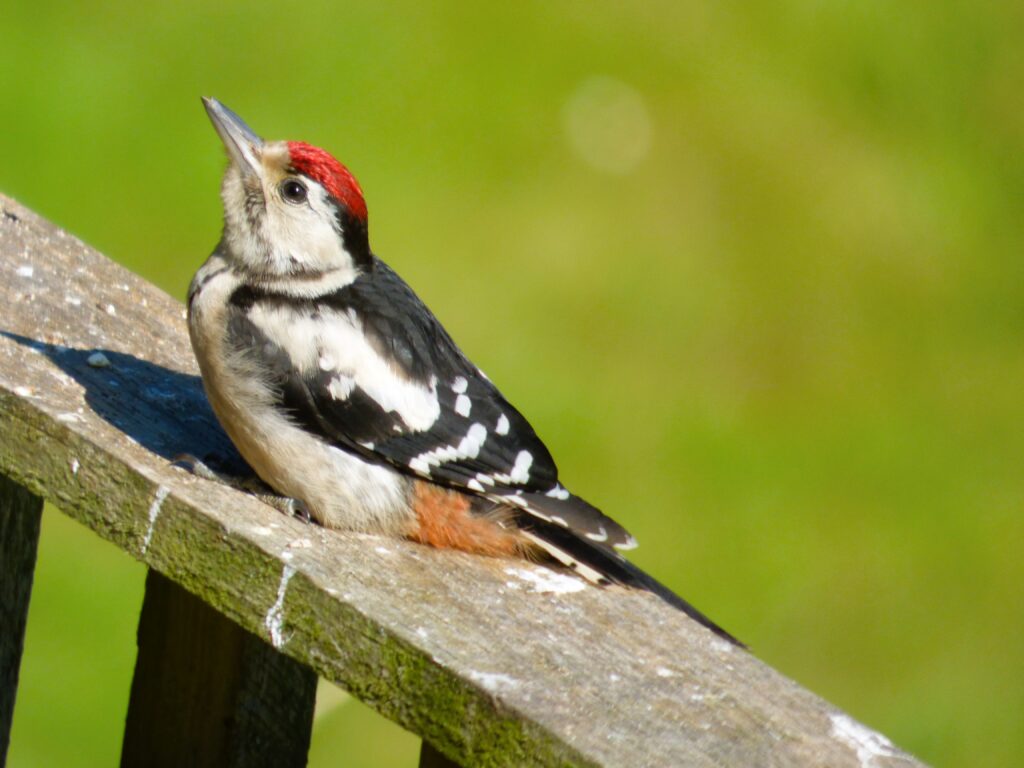Meet the Juveniles – Woodpecker Teenagers in the Garden
Woodpecker Teenagers in the Garden
Meet the Juveniles – There’s something endlessly charming about juvenile Great Spotted Woodpeckers. They arrive into the world all feathers and fluff, full of confidence but absolutely no coordination. If you’ve ever seen one try to land on a swinging feeder and completely miss, you’ll know what I mean.
They’re noisy, curious, and often completely unbothered by anything going on around them. They haven’t quite learned the subtle movements of adult birds yet. They bounce, fidget, and stare at everything as if it’s brand new which, of course, it is. For me, juveniles are one of the best parts of summer.
They represent the full circle of the nesting season. You’ve heard the drumming, you’ve spotted the adults collecting food, and suddenly, here’s the result: a bright red-crowned teenager, wide-eyed and ready to take on the world one wobbly hop at a time. Watching them figure things out is not just sweet it’s genuinely fascinating.
Juvenile woodpeckers are easy to identify once you know what to look for. Unlike adult males who have a red patch on the nape and adult females who have no red at all, juveniles sport a full red cap across the top of the head.
This red crown is bold and obvious, especially when the sun catches it just right. It begins to fade after a few weeks, so the earlier in the summer you spot them, the more vibrant the colour. You’ll also notice differences in behaviour. Juveniles often beg for food with loud, insistent calls even while standing next to a full feeder.
They may shadow an adult around the garden or appear on their own, looking slightly confused about how the whole feeding process works. Here are a few signs you’ve got a juvenile on your hands:
- Bright red crown stretching from beak to nape
- Slightly fluffier and scruffier appearance
- Clumsy landings and slow feeder access
- Loud calls and occasional wing fluttering
- Tendency to pause and observe before eating
One of the most heart warming things is watching the interaction between juveniles and adults. I’ve seen adult males gently nudge food towards a youngster, only to have it fall off the perch moments later. Sometimes the adult seems to lose patience entirely, flying off and leaving the juvenile behind to figure it out.
Other times, two juveniles arrive at once, chasing each other in circles before settling on opposite sides of the feeder like squabbling siblings. These moments are golden. Not just for filming, but for understanding bird behaviour on a deeper level. It’s a reminder that even wild animals have learning curves, personalities, and family dynamics. You’re not just watching birds. You’re watching life play out in miniature.
As the weeks go by, you’ll notice the juveniles becoming more competent. The red crown fades gradually males begin to develop the red nape patch, while females lose the red altogether. Their movements become more refined.
They learn to land smoothly, feed without fuss, and even start mimicking adult drumming patterns. If you’ve been lucky enough to observe a juvenile over several visits, you may find yourself getting attached. I certainly do.
There’s a particular young bird I nicknamed “Speckle” who visited my feeder every day for nearly three weeks. At first, he fell off more often than he fed. But by the end of July, he’d mastered the routine and started behaving more like the adults. It’s moments like that tiny milestones in a woodpecker’s life that make this whole project feel worthwhile.
If you want to attract and support juveniles in your garden, summer is the perfect season to start. Keep food available consistently, especially soft or easy-to-access options like fatballs, suet pellets, crushed peanuts, and mealworms.
Provide cover so young birds can approach safely. Limit loud noises and fast movement near the feeding area they startle more easily than adults. And most of all, be patient. Juveniles may seem chaotic, but they’re learning every second.
Watching that progression from first visit to confident feeder pro is one of the most rewarding experiences for any garden birdwatcher. They’re not just the future of the species. They’re the reason the Woodpecker Diaries exists at all.
